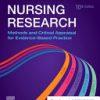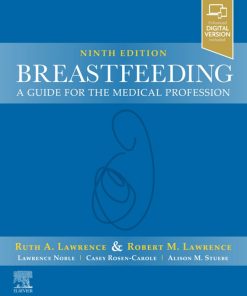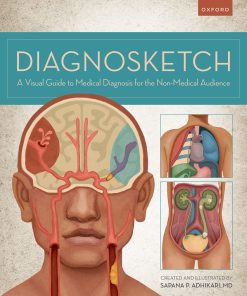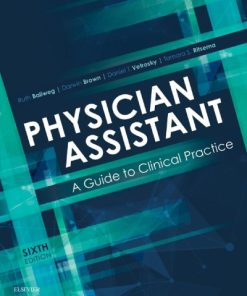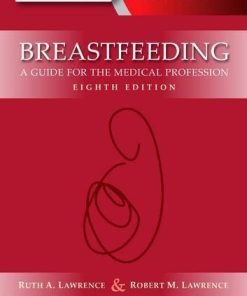(Ebook PDF) Breastfeeding A Guide for the Medical Professional 9th Edition by Ruth Lawrence, Robert Lawrence 0323680151 9780323680158 full chapters
$50.00 Original price was: $50.00.$25.00Current price is: $25.00.
Breastfeeding : A Guide for the Medical Professional 9th Edition by Ruth A. Lawrence, Robert M. Lawrence – Ebook PDF Instant Download/DeliveryISBN: 0323680151 9780323680158
Full download Breastfeeding : A Guide for the Medical Professional 9th Edition after payment.

Product details:
ISBN-10 : 0323680151
ISBN-13 : 9780323680158
Author: Ruth Lawrence, Robert Lawrence
Written and edited by leading physicians, Breastfeeding: A Guide for the Medical Profession, 9th Edition, offers comprehensive, dependable information and guidance in this multifaceted field. Award-winning author and co-founder of the Academy of Breastfeeding Medicine, Dr. Ruth Lawrence, and her son, Dr. Rob Lawrence, ensure that you’re brought fully up to date on everything from basic data on the anatomical, physiological, biochemical, nutritional, immunological, and psychological aspects of human lactation, to the problems of clinical management of breastfeeding—all in a highly readable, easily accessible desk reference.
Breastfeeding : A Guide for the Medical Professional 9th Table of contents:
1. Breastfeeding in a New Era
Abstract
Early History of Breastfeeding
Cultural Practices
Modern History of Breastfeeding
Disparities in Breastfeeding
Measures of Breastfeeding Success
Mortality Studies in Breastfed and Artificially Fed Infants
Sudden Infant Death Syndrome
Measuring Costs of Not Breastfeeding or Money Saved from Increased Breastfeeding
The Mammary Gland and Science
Support for the Breastfeeding Women of the World
Summary
2. Anatomy of the Breast
Abstract
Gross Anatomy
Embryonic Development
Fetal and Prepubertal Development
Pubertal Development
Anatomic Location
Abnormalities
Corpus Mammae
Nipple and Areola
Blood Supply
Lymphatic Drainage
Innervation
Microscopic Anatomy
Mature Mammary Gland
Mammary Gland in Pregnancy
Lactating Mammary Gland
Postlactation Regression of Mammary Gland
Summary
3. Physiology of Lactation
Abstract
Stages of Mammary Gland Development
Apoptosis in the Mammary Gland
Hormonal Control of Lactation
Embryogenesis
Mammogenesis: Mammary Growth
Lactogenesis—Initiation of Milk Secretion
Prolactin
Human Placental Lactogen and Human Growth Hormone
Oxytocin
Stage III Lactogenesis (Galactopoiesis): Maintenance of Established Lactation
Hormonal Regulation of Prolactin and Oxytocin
Changes in Breast Hemodynamics in Breastfeeding Mothers
Understanding the Myth of “MILK COMING IN”
Maternal Effects of Suckling
Concentrations of Oxytocin in Milk
Role of Prostaglandins as Milk Ejectors
Production of Hormones by the Mammary Gland
Feedback Inhibitor of Lactation (FIL)
Maternal Adaptation to Lactation
Delay in the Onset of Lactogenesis
Synthesis of Human Milk
Function of Cellular Components of the Lactating Breast
Intermediary Metabolism of Mammary Gland
Carbohydrates
Fat
Protein
Ions and Water
Milk Enzymes
Cellular Components
Involution: Weaning and Apoptosis
Summary
4. Biochemistry of Human Milk
Abstract
Normal Variations In Human Milk
Stages of Lactation
Lactogenesis Stage II
Carbohydrates
Minerals
Trace Elements
Vitamins
Enzymes
Hormones
Bile Salts
Epidermal Growth Factor
5. Host-Resistance Factors and Immunologic Significance of Human Milk
Abstract
Overview
Protective Effect of Breast Milk
Dose-Response Relationship
Developmental Deficiencies In Infants’ Immune Systems
Bioactive Factors
Mucosal Immunity
Cellular Components of Human Colostrum and Milk
Survival of Maternal Milk Cells
Humoral Factors
Other Bioactive Factors
Mucosal Immune System
Toll-Like Receptors
Microbiota
Genetics and Epigenetics
Effectiveness of Human Milk in Controlling Infection
Antiinflammatory Properties
Allergic Protective Properties (See on Human Milk as Prophylaxis in Allergy)
Protection Against Chronic Disease in Childhood
Summary
6. Population Health and Informed Feeding Decisions
Abstract
Breastfeeding and Maternal Health
Breastfeeding and Infant Health
Contraindications to Breastfeeding
Population Health Impact
From Population to Patient: Counseling the Feeding Decision
7. Practical Management of the Nursing “Dyad”
Abstract
Basic Practical Management of Lactation
Prenatal Breastfeeding Education and Management
Going Home from The Hospital or Birthing Center
Part 2: Diagnosing Breastfeeding Problems
Overview
Maternal Problems
Milk Transfer/Observing a Latch or Pump Session
Expression of Milk to Feed
One-Breast/Two-Breast Feedings
Breast Rejection or Nursing “Strikes”
Infant-Side Problems
8. Maternal Nutrition and Supplements for Mother and Infant
Abstract
Nutrition for Breastfeeding
Impact of Maternal Diet on Milk Production
Maternal Nutrition: Immunologic Substances
Recommendations for Nutritional Support During Lactation
Foods to Avoid
Color of Milk and Maternal Diet
9. Weaning
Abstract
Infant’s Need
Cultural Patterns of Weaning
Role of Development In Initiation of Weaning
Introduction of Solids
Mothers’ Choices
Weaning Process
Infant-Initiated Weaning
Emergency Weaning
Milk Fever
Growth and Weaning
Changes in Milk Composition During Gradual Weaning
Physician’s Role In Weaning
Understanding The Reasons to Wean
Closet Nursing
Working Mothers and Weaning
Legal Issues
Why do some women not breastfeed?
Summary
10. Normal Growth, Growth Faltering, and Obesity in Breastfed Infants
Abstract
Normal Growth
Growth Faltering (Failure To Thrive)
Maternal and Infant Obesity and Breastfeeding
Childhood Obesity and Breastfeeding
Nutritional Programming
Summary
11. Medications, Herbal Preparations, and Natural Products in Breast Milk
Abstract
Misinterpretation of Drug Data
Possible Risk of Drug Appearing in Breast Milk
Important Variables Regarding Medications In Human Breast Milk
Infant Related Medication Factors
Characteristics of Drugs
Pharmacokinetic Principles
Infant-Related Factors
Milk-to-Plasma Ratio for Drugs is Usually Not Useful
Evaluating Drug Data
Safety for Infant
Correlation of Drug Safety in Pregnancy and Lactation
Classification Systems
Specific Drug Groups
Drugs of Abuse and Alcohol
Herbs and Herbal Teas
Galactagogues
Lactation Suppression
Cardiovascular Drugs and Diuretics
Central Nervous System Drugs
Psychotherapeutic Agents
Migraines and Headaches
Medications for Autoimmune Disorders in Lactation
Pesticides and Pollutants
Radioactive Materials
Dermatologic Medication
Immunizations
Summary of Medications in Breast Milk
12. Transmission of Infectious Diseases Through Breast Milk and Breastfeeding
Abstract
Evidence for Transmission
Infection-Control Considerations
Misadministration of Breast Milk
Clinical Syndromes and Conditions
Bacterial Infections
Staphylococcal Infections
Streptococcal Infections
Viral Infections
Hepatitis in the Mother
Human Papillomavirus
Retroviruses
Spirochetes
Parasites
Candida Infections
Summary
13. Breastfeeding Infants With Problems
Abstract
Procedures and Surgery
Perinatal Issues
Gastrointestinal Diseases
Respiratory Illness and Otitis Media
Metabolic Disease
Neurologically Impaired Infants
Endocrine Diseases
Hyperbilirubinemia and Jaundice
Suckling Problems Related to Anatomy and Neural Disorders
Intestinal Tract Disorders
Malformations of central nervous system
Congenital Heart Disease
Sudden Infant Death Syndrome
Oral Health
14. Premature Infants and Breastfeeding
Abstract
Benefits of Human Milk for the Preterm
Gastrointestinal Tract Development
Gastrointestinal Priming
Colostrum
Low-Birth-Weight Infants
Optimal Growth for Premature Infants
Special Properties of Preterm Milk
Use of Human Milk
Gastrointestinal Characteristics of Premature Infants
Use of Human Milk for Premature Infants
Supplementation of Mother’s Own Milk or Pooled Human Milk
Artificial Fortification of Human Milk
Fortification of Human Milk with Human Milk
Long-Term Follow-Up of Growth Parameters in Infants with Very Low-Birth-Weight
Antimicrobial Properties of Preterm Breast Milk
Donor Milk
Kangaroo Care and Skin-to-Skin Care
Milk Production by Mothers of Premature Infants
Who Produces Milk for Low-Birth-Weight or Small-For-Gestational-Age Infants?
Feeding the Near-Term Infant (35 TO 37 Weeks’ Gestation) at the Breast
Premature Infants of 28 6/7 Weeks to 32 6/7 Weeks
Breastfeeding the Extremely Premature Infant
Small-For-Gestational-Age Infants
Transitioning from Hospital to Home
Improving Milk Production
Concluding Recommendations
15. Medical Complications of Mothers
Abstract
Shared Decision-Making
Management of Acute Conditions in the Breastfeeding Mother
Pregnancy Complications
Breastfeeding and Maternal Chronic Conditions
Endocrine and Metabolic Disorders
Gastrointestinal Disorders
Pulmonary Disorders
Autoimmune Disorders
Neurologic Disorders
Renal Disorders
Cardiac Disorders
Organ Transplant
Musculoskeletal Disorders
Psychiatric Disorders
Summary
16. Breast Conditions in the Breastfeeding Mother
Abstract
Breast Physical ExamInation
Anatomic Variants
Nipple-Areolar Complex
Obstructive and Inflammatory Conditions
Benign Breast Masses, Breast Pain, and Other Conditions
Breast Cancer and Breastfeeding
Plastic Surgery and Breastfeeding
17. Human Milk and Atopic Disease
Abstract
Atopic Disease
Natural History of Food Allergy
Enteromammary Immune System
Prophylaxis of Allergy
Recommendations of the Committee on Nutrition and Section on Allergy and Immunology of the American Academy of Pediatrics
Immunologic Aspects of Allergy
Cow Milk Allergy
Food Allergy in Breastfed Infants
Celiac Disease
Summary
18. Breastfeeding and Return to Work or School
Abstract
Breastfeeding and Employment
Demographic Disparities
Maternal Employment Affects Breastfeeding Exclusivity and Duration
Decision-Making Regarding Continuing Breastfeeding
Counseling Breastfeeding Mothers Who Choose to Work
Summary
19. Induced Lactation and Relactation (Including Nursing an Adopted Baby) and Cross-Nursing
Abstract
Historical Perspective
Induced Versus Inappropriate Lactation
Animal Studies
Induced Lactation
Management of Mother and Infant
Protocols for Induced Lactation
Guidelines for Induced Lactation
When Adopting Mothers are a Same-Sex Couple
Relactation or Reinitiation of Lactation
Special Devices
Relactation During Disasters
Wet Nursing, Cross-Nursing, Co-Feeding, or Milk Sharing
Summary
20. Chestfeeding and Lactation Care for LGBTQ+ Families (Lesbian, Gay, Bisexual, Transgender, Queer, Plus)
Abstract
Creating a Respectful Health Care Environment
Physiology of Lactation in Special Circumstances
Transwomen (A Female at Birth, Affirmed Male)
Two or More Lactating Parents and Co-Lactation
Surrogacy and Adoption
Factors Common to all of These Cases
21. Reproductive Function During Lactation
Abstract
Lactation and Fertility
The Lactational Amenorrhea Method
Safety and Efficacy of other Contraceptive Methods During Lactation
Patient-Centered Counseling on Sexuality, Birth Spacing, and Contraception
22. The Collection and Storage of Human Milk and Human Milk Banking
Abstract
Prevalence of Human Milk Expression
Techniques for Human Milk Collection
Evaluation of Milk Expression Methods
Pumping in the Neonatal Intensive Care Unit
Storage Containers
Human Milk Storage Recommendations
Risk of Human Milk Expression on Breastfeeding
Risks of Feeding Pumped Milk on Infant Health
Cultural Aspects Concerning Human Milk Collection
Historical Perspective Human Milk Sharing and Banking
Informal Milk Sharing
Human Milk Banking
Donor Human Milk
Financial Aspects of Banking
Cultural Issues Pertaining to Milk Sharing
23. Infant Feeding After a Disaster
Abstract
Benefits of Breastfeeding After a Disaster
Previous Experiences Feeding Infants
Challenges in Feeding Infant Formula After Disasters
Preparedness Plans to Support Breastfeeding and Safe Infant Feeding After a Disaster
Breastfeeding and Radiation Exposure
24. Establishing a Breastfeeding Medicine Practice or Academic Department
Abstract
Who is a Breastfeeding Medicine Provider?
Choosing a Model Type
Business Plan
Documentation to Support Sound Clinical Practice, for Billing, and to Limit Liability
Community Integration, Access, and Follow-Up
Inpatient Rounding and Support
Summary
25. Breastfeeding Support Groups and Community Resources
Abstract
Support for Breastfeeding
Historical Perspective
Development of Mother Support Groups
Government Organizations
Nongovernmental Organizations
Lactation Consultants
Peer Counseling
Summary
26. Educating and Training Medical Professionals
Abstract
Provider Education on Breastfeeding in the Twentieth Century
Principles of Educating Providers
Suggested Learning Objectives by Discipline
Formats
Specific Curricula
People also search for Breastfeeding : A Guide for the Medical Professional 9th:
nice guidelines for breastfeeding
breastfeeding guide by age
nhs guidelines on breastfeeding
breastfeeding a guide for the medical profession 9th edition
breastfeeding a guide for the medical profession
You may also like…
Education Studies & Teaching - Teaching & Teacher Training
Medicine
Diagnosketch: A Visual Guide to Medical Diagnosis for the Non-Medical Audience Sapana Adhikari



